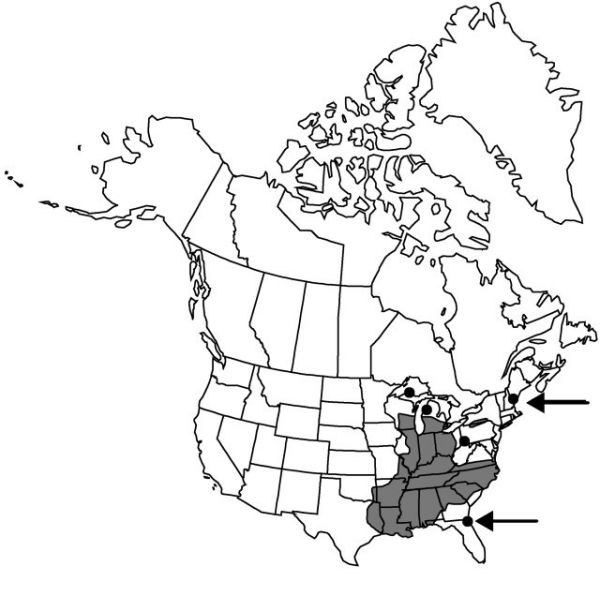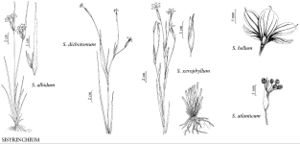Sisyrinchium albidum
Atlantic J. 1: 17. 1832.
Herbs, perennial, cespitose, yellowish green to light olive when dry, to 4 dm, not glaucous. Stems apparently simple, not wiry, obviously winged, 1.5–3.4 mm wide, glabrous to scabrous, margins entire to denticulate apically, similar in color and texture to stem body. Leaf-blades usually glabrous, bases not persistent in fibrous tufts. Inflorescences paired, closely subtended by long, bractlike leaf that often obscures first (inner) inflorescence, sessile or occasionally second (outer) with branch to 5 mm; spathes green or occasionally with purplish tinge, glabrous or occasionally scabrous, keels usually denticulate; outer spathe of outer rhipidium 14–30 mm, 0.3–3.7 mm longer than inner, outer spathe of inner rhipidium 1–3.5 mm shorter than inner, both tapering evenly towards apex, margins distinct or rarely connate basally to 1 mm; inner with keel straight or somewhat curved, hyaline margins 0.1–0.5 mm wide, apex acute to obtuse or rarely truncate, ending 0.2–2.5 mm proximal to green apex. Flowers: tepals white or blue, bases yellow; outer tepals 6–12.5 mm, apex emarginate, aristate; filaments connate ± entirely, slightly stipitate-glandular basally; ovary similar in color to foliage. Capsules tan to light-brown, ± globose, 2.8–4 mm; pedicel spreading or ascending. Seeds globose to obconic, lacking obvious depression, 0.8–1.1 mm, granular to rugulose. 2n = 32.
Phenology: Flowering spring–early summer.
Habitat: Roadsides and open slopes, prairies, or rich open woods, often on shallow rocky or sandy soil
Elevation: 0–600 m
Distribution

Ont., Ala., Ark., Fla., Ga., Ill., Ind., Ky., La., Maine, Mich., Miss., Mo., N.Y., N.C., Ohio, Okla., Pa., S.C., Tenn., Tex., Va., Wis.
Discussion
Selected References
None.
